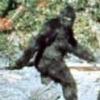Hypothetically they could but there are not many examples of parallel evolution taken to the necessary degree. The more similar the end result and the deeper in time the split, the less likely that option becomes. Example would be mara and european hares .. though they evolved to fill a very similar niche on different continents, their differences are as obvious as their similarities.
The farther we go back in time for a split from the known pongid/human tree, the more likely that either fossils will exist somewhere or the thing is imaginary ... and the tracks I've cast were real, the plaster impressions were real, and I can tell you that in the setting where I found "my" trackline, a hoax was not possible and nothing exists to misidentify.
I think the evidence points to a very late split off the known "tree" or a known split that underwent very rapid physical adaptation due to extreme, extreme climate stress in isolation from the parent population. That isn't something I "know", rather something I compute as best guess based on the evidence available to me.
Setting Ketchum aside for a while and focusing on the "theory" of hybridization, the idea has several points of biological merit. First, it has been reported that there are two similar forms, one more apelike with cruder "speech", one more humanlike (in feature) with more articulate "speech". Both are similarly massive but the more ape type is reported as having even more extreme musculature than the other. Second, broad variation in size and color. Third, variations in number of digits, especially toes. Plus other things including native accounts of abducted women who return pregnant with seemingly partially non-human offspring. To me, taken on the whole, it suggests one of two possibilities, either a species in severe decline with a lot of mutations reinforced by massive inbreeding -or- (the option I lean towards) a hybridization event which is still incomplete such that the genes of the 2 parent species are not homogeneously spread across the whole population yet.
I find what is happening out there very fascinating. I think there is something quite unique occurring right under our noses that most humans are overlooking.
MIB



